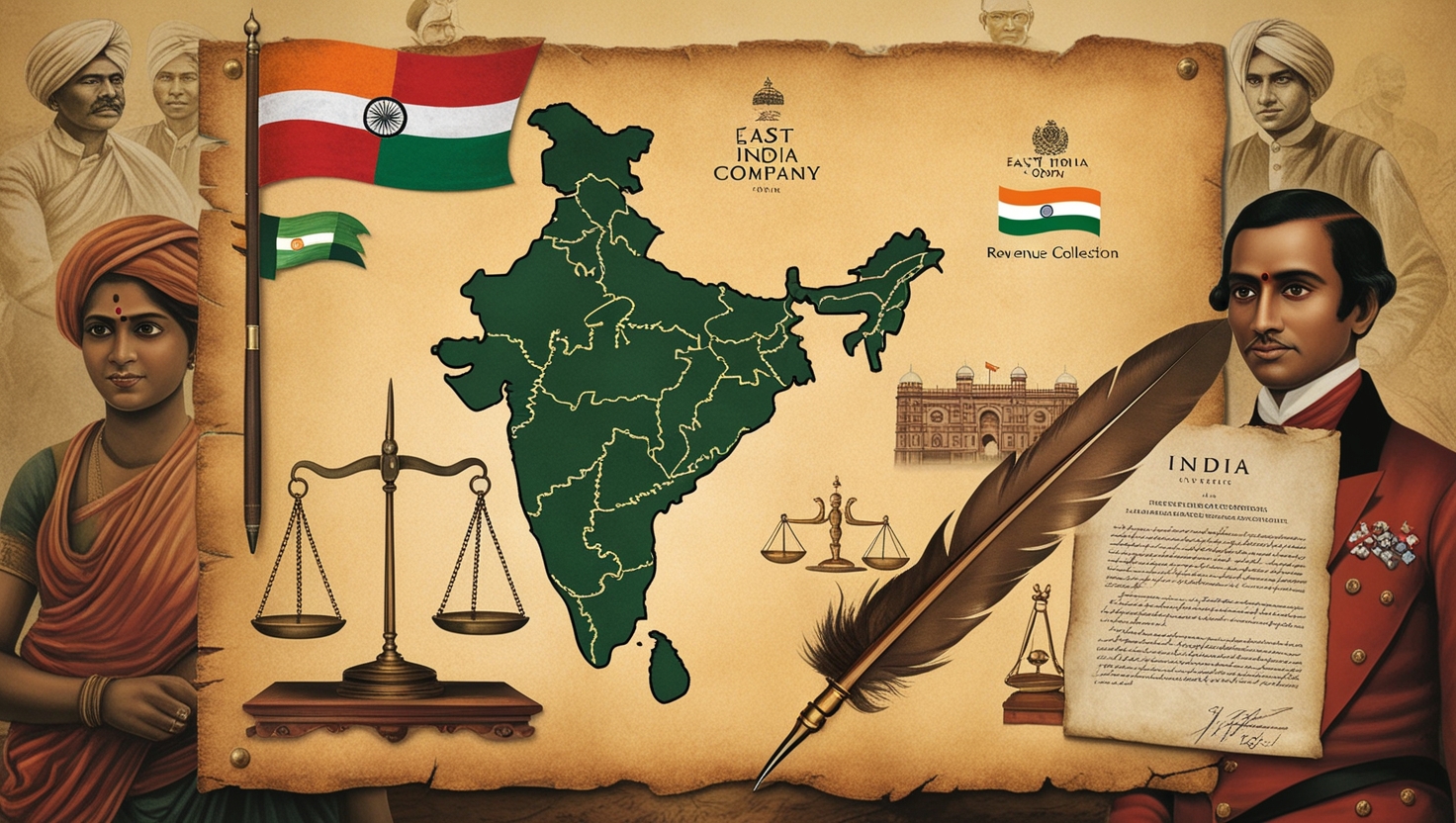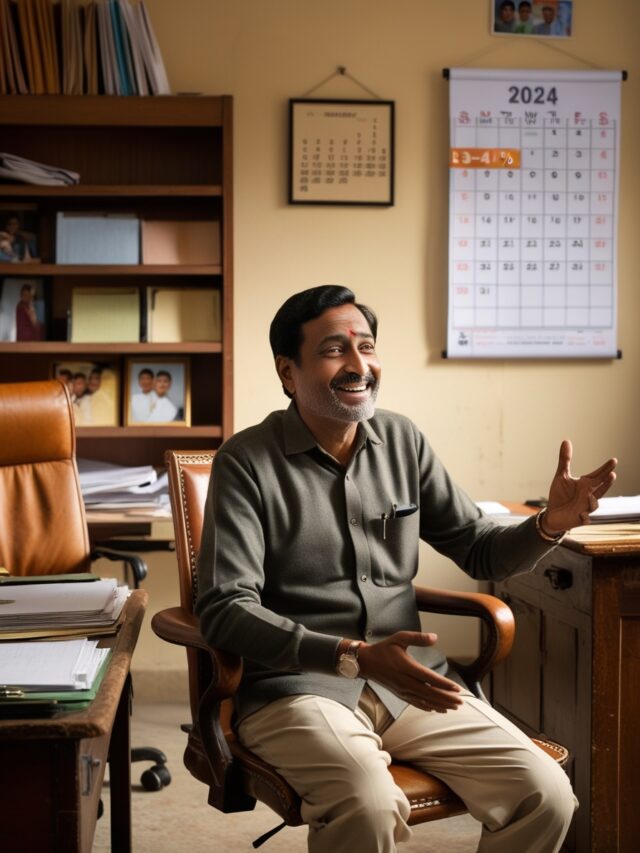
The East India Company Rule – Revenue, Reforms GK MCQ section provides a comprehensive understanding of the key reforms and revenue policies implemented by the British East India Company during their rule in India. Through a series of multiple-choice questions (MCQs), this guide aims to enhance your knowledge of the economic, political, and administrative changes that shaped India’s history under colonial rule.
1. During the time of Governor-General Lord Ellenborough, which among the following acts declared slavery as illegal?
- Act VI
- Act V
- Act III
- Act VIII
Show Answer
Answer: Act V
The Act V of 1843, during the tenure of Governor-General Lord Ellenborough, declared slavery as illegal in British India. This significant legal reform marked a step toward the abolition of slavery and the protection of individual rights.
2. Who among the following introduced the subsidiary alliance system in India?
- Lord Clive
- Lord Wellesley
- Lord Cunningham
- Lord Canning
Show Answer
Answer: Lord Wellesley
The doctrine of subsidiary alliance was introduced by Lord Wellesley, who served as the British Governor-General of India from 1798 to 1805. The Nizam of Hyderabad was the first Indian ruler to enter into such an alliance in 1798. The doctrine involved Indian rulers accepting the military protection of the British East India Company, but it often resulted in a loss of sovereignty.
3. During the company rule, the Hindu Widows Remarriage Act was drafted by_?
- Lord Canning
- Lord Dalhousie
- Lord Hardinge
- None of the above
Show Answer
Answer: Lord Dalhousie
The Hindu Widows’ Remarriage Act, 1856 (also Act XV, 1856), was a crucial reform enacted on 25 July 1856 during the time of Lord Dalhousie. This act legalized the remarriage of Hindu widows in all jurisdictions of India under East India Company rule, bringing about a significant social change by allowing widows to remarry.
4. Under which among the following treaties, did the British East India Company secure the Diwani right of Bengal, Bihar, and Orissa?
- Alinagar
- Faizabad
- Allahabad
- Benaras
Show Answer
Answer: Allahabad
The Treaty of Allahabad, signed on 16 August 1765, was a direct outcome of the Battle of Buxar (1764). Robert Clive, the Governor General of Bengal, negotiated this separate treaty with Mughal Emperor Shah Alam II and Nawab of Awadh Shuja-ud-Daula. Under this treaty, the Mughal Emperor granted the Fiscal Rights (Diwani) over Bengal, Bihar, and Orissa to the East India Company.
5. Who said that the British established a robber state in Bengal between 1765 and 1772?
- G. W. Forrest
- Lord Macaulay
- K. M. Panikkar
- Nand Lal Chatterji
Show Answer
Answer: K. M. Panikkar
K.M. Panikkar, the Indian scholar, journalist, historian, administrator, and diplomat, noted that between 1765 and 1772, the British had effectively established a “robber state” where they freely plundered and looted under the pretext of their granted rights. This period represented a phase of exploitation and economic extraction by the British East India Company.
6. Mahalwari System of Revenue Settlement was introduced in which of the following?
- Bengal
- Bombay
- Madras
- North-west provinces
Show Answer
Answer: North-west provinces
The Mahalwari system was introduced in various regions, including the North-west provinces, the Punjab, Delhi, parts of Central India, and Uttar Pradesh. In this system, land was not owned by individuals but by groups of estates or villages known as Mahals. The Mahal was collectively considered the landlord, and revenue was collected from the head of the Mahal, known as the Talukdar.
7. As per Warren Hastings reforms, which among the following courts was set up as an appeal court in criminal cases?
- Circuit court
- Provincial Court
- Sadar Diwani Adalat
- Sadar Nizamat Adalat
Show Answer
Answer: Sadar Diwani Adalat
During Warren Hastings’ tenure, two courts were established in each district: the Diwani Adalat, responsible for deciding civil cases, and the Faujdari Adalat, which handled criminal cases. The Sadar Diwani Adalat served as a Court of Appeal for civil cases, providing a structured judicial system.
8. Which among the following was also known as the Western Presidency in the early times of the East India Company?
- Bombay
- Surat
- Panaji
- Pune
Show Answer
Answer: Bombay
The Western Presidency, also known as the Surat Presidency, existed from 1612 to 1687 and included various factories on the west coast of India, such as Ahmadabad, Balasore, Bombay, and Hooghly. The presidency was terminated in 1687 when the seat of administration was moved to Bombay.
9. Under which among the following Governor-Generals of India, was the Public Works Department started in 1848?
- Lord Dalhousie
- Lord William Bentinck
- Lord Wellesley
- Lord Viscount Canning
Show Answer
Answer:Lord Dalhousie
During Lord Cornwallis’s tenure, various administrative changes were implemented, including the dismissal of high Indian officials and the reservation of posts worth more than £500 a year for Europeans. His initiatives led to the establishment of the Indian Civil Service and the Europeanization of higher postings.
10. Lord William Bentinck is credited for which of the following in Indian History?
- Education reforms
- Laws
- Abolition of sati
- Local government
Show Answer
Answer: Abolition of sati
Lord William Bentinck is credited with promoting the use of English as the medium of instruction and the court language, replacing Persian. This was part of his educational reforms, reflecting a broader shift in language policy.
Q11: During the tenure of which of the following Governor-Generals, were all high Indian officials dismissed, and all posts worth more than £500 a year reserved for Europeans?
1. Lord Dalhousie
2. Lord Curzon
3. Lord Wellesley
4. Lord Cornwallis
Show Answer
Answer: 4
Explanation: During Lord Cornwallis’s tenure, all high Indian officials were dismissed, and all posts worth more than £500 a year were reserved for Europeans. He is known for the establishment of Indian Civil Service and the Europeanization of higher postings.
Q12: Who among the following made English the court language, replacing the Persian Language?
1. Lord Macaulay
2. Lord Bentinck
3. Charles Wood
4. Lord Curzon
Show Answer
Answer: 2
Explanation: Lord William Bentinck is credited with making English the medium of instruction and the court language, replacing Persian, as part of his educational reforms.
Q13: Which among the following Governor-Generals/Viceroys championed the cause of female education and made an annual donation towards this?
1. Lord Dalhousie
2. Lord Canning
3. Lord Elphinstone
4. Lord Curzon
Show Answer
Answer: 4
Explanation: Lord Curzon, during his tenure, advocated for female education and supported this cause by making an annual donation. His efforts were part of a broader set of educational reforms during British rule.
Q14: Which of the following is/are correct statements about Clive’s dual administration?
1. It gave rise to immediate conflict between the British and the Nawab.
2. It led to the Anglo-Maratha clash.
3. It separated power from responsibility.
Choose the correct code
1. Only 2 & 3
2. Only 3
3. 1, 2 & 3
4. None
Show Answer
Answer: 1
Explanation: Clive’s dual administration sought to define the respective positions of the Nawab and the East India Company, reducing the potential for immediate conflicts between the two. It also separated power from responsibility, granting the English the right to collect revenue while distancing them from internal administration.
Q15: As per Warren Hastings reforms, which among the following courts was set up as an appeal court in criminal cases?
1. Circuit court
2. Provincial Court
3. Sadar Diwani Adalat
4. Sadar Nizamat Adalat
Show Answer
Answer: 3
Explanation: Warren Hastings established two courts in each district: the Diwani Adalat to decide civil cases and the Faujdari Adalat to try criminal cases. The Sadar Diwani Adalat was set up as a Court of Appeal in civil cases.
Q16: Which among the following land revenue system was marked by peasant proprietors?
1. Zamindari System
2. Mahalwari System
3. Ryotwari System
4. Jagirdari System
Show Answer
Answer: 3
Explanation: The Ryotwari system was implemented in Bombay and Madras, where land was held by peasant proprietors who paid land revenue directly to the state. Under this system, revenue was assessed on each individual holding pieces of land separately.
Q17: Nizamat which was a part of the dual government of Bengal, refers to which of the following?
1. Military power and criminal justice
2. Revenue and civil justice
3. Land tax
4. Tax collected on sea trade
Show Answer
Answer: 1
Explanation: The term Nizamat referred to the aspects of military power and criminal justice, which the East India Company received from the Subedar (ruler). The company, in parallel, obtained the Diwani (revenue and civil justice) rights from the Mughal Emperor Shah Alam II.
Q18: What was the main objective of setting up Lord Clive’s Fund?
1. To give pension to the rulers of Bengal
2. To help the servants of the company during financial difficulty
3. To help the financially weaker section of Bengal
4. To help the Nawab of Bengal during war
Show Answer
Answer: 2
Explanation: To help the servants of the company during financial difficulty
Explanation: Lord Clive’s Fund was set up by Lord Clive himself to help the servants of the company during financial difficulty, as there was no pensioning system for the servants.
Q19: Which of the following about the administration of the dual government of Lord Clive is/are correct?
1. The company was the actual Diwan.
2. Mohammed Raza Khan was appointed to control the administration of Bengal.
3. Raja Shitab Rai was appointed to control the administration of Bihar.
4. All of the above
Show Answer
Answer: 2
Explanation: Mohammed Raza Khan was appointed to oversee the administration of Bengal during the British East India Company’s rule. The company acted as the de facto Diwan, while two Naib Diwans (Deputy Diwans) were responsible for the administrative control of Bengal and Bihar.
Q20: Who said that The dual administration made confusion more confounded and corruption more corrupt?
1. Historian Key
2. Lord Clive
3. Mr. Bechar Smith
4. None of the above
Show Answer
Answer: 1
Explanation: The dual administration of Bengal, which was introduced during the British East India Company’s rule, faced criticism from historians like Key. Key pointed out that the dual administration system only added more confusion and corruption to the existing administrative structure, creating a complex governance framework.
Q21: Who abolished the dual administration system established by Lord Clive?
1. Lord Warren Hastings
2. Lord Curzon
3. Lord Amherst
4. Lord Linlithgow
Show Answer
Answer: 1
Explanation: Lord Warren Hastings, the Governor of Bengal, abolished the dual administration system in 1772. This marked a significant reform as it led to the transfer of the Diwani right (revenue collection) to the East India Company, streamlining the administration.
Q22: Which of the following is/are correct statements about Clive’s dual administration?
1. It gave rise to immediate conflict between the British and the Nawab.
2. It led to the Anglo-Maratha clash.
3. It separated power from responsibility.
Choose the correct code
1. Only 1 & 2
2. Only 2 & 3
3. Only 3
4. 1, 2 & 3
Show Answer
Answer: 2
Explanation: Clive’s dual administration, introduced to define the roles of the Nawab and the East India Company, aimed to prevent immediate conflicts between the two entities. The system established separate responsibilities for each, with the English having the authority to collect revenue but no longer involved in internal administration.
appeal court in criminal cases?
1. Circuit court
2. Provincial Court
3. Sadar Diwani Adalat
4. Sadar Nizamat Adalat
Show Answer
Answer: 3
Explanation: Under Warren Hastings, two types of courts were established in each district: the Diwani Adalat for civil cases and the Faujdari Adalat for criminal cases. Additionally, the Sadar Diwani Adalat served as a Court of Appeal for civil cases.
Q24: During the time of Warren Hastings, who was responsible for collecting land revenue?
1. Amils
2. Mahamatras
3. Collectors
4. Ayukts
Show Answer
Answer: 1
Explanation: After receiving the Diwani right, the East India Company delegated the responsibility of collecting land revenue to Amils. Subsequently, supervisors were appointed to oversee this task. Warren Hastings played a crucial role in appointing collectors to take charge of land revenue collection.
Q25: To supervise the land revenue collection process during the reign of Warren Hastings, a Board of Revenue was set up in which of the following places?
1. Calcutta
2. Monghyr
3. Murshidabad
4. Bhagalpur
Show Answer
Answer: 1
Explanation: During Warren Hastings’ rule, collectors were appointed to manage the collection of land revenue. The system involved auctioning the land to the highest bidder for a fixed term of five years. To oversee the entire process, a Board of Revenue was established in Calcutta.
Q26: During the reign of Warren Hastings, Sadar Nizamat Adalat was established in which place?
1. Murshidabad
2. Calcutta
3. Bhagalpur
4. Monghyr
Show Answer
Answer: 1
Explanation: Under Warren Hastings, two significant judicial courts were established. The Sadar Nizamat Adalat was situated in Murshidabad and the Sadar Diwani Adalat in Calcutta. The head of the Sadar Nizamat Adalat was the Nayeb Nazim (representative of the Nawab), and the Governor and the Council supervised its proceedings.
Q27: Cornwallis appointed many collectors during the reforms of 1787. The collectors were responsible for which of the following duties?
1. Revenue collection
2. Acting as a Magistrate
3. Acting as a Judge
4. All of the above
Show Answer
Answer: 4
Explanation: Lord Cornwallis reduced the number of districts from 36 to 23, with covenanted servants of the East India Company appointed as collectors. These collectors had three distinct roles: revenue collection, acting as magistrates, and acting as judges, performing these duties separately.
Q28: During the time of Lord Cornwallis, the Sadar Diwani Adalat used to take cases of more than which of the following amounts?
1. Rs. 500
2. Rs. 1000
3. Rs. 2500
4. Rs. 5000
Show Answer
Answer: 2
Explanation: The Sadar Diwani Adalat was responsible for cases involving amounts exceeding Rs. 1000, and its decisions were generally considered final. However, cases involving amounts over Rs. 5000 could be appealed to the King in England.
Q29: Lord Cornwallis transferred the Sadar Nizamat Adalat to which of the following places?
1. Calcutta
2. Mushirdabad
3. Bhagalpur
4. Monghyr
Show Answer
Answer: 1
Explanation: Lord Cornwallis relocated the Sadar Nizamat Adalat from Murshidabad to Calcutta, changing its meeting frequency to at least once a week. This court handled criminal justice, with the Governor-General-Council having control over the power of mercy.
Q30: Which among the following reforms in criminal justice was taken by Lord Cornwallis in 1790?
1. Sadar Nizamat Adalat was transferred to Calcutta
2. Nawab’s control over the Sadar Nizamat Adalat was stopped
3. With the help of Kadi and Muftis, the governor-general used to control the work
4. The court used to meet at least once a week
Show Answer
Answer: 4
Explanation: The court used to meet at least once a week
Explanation: Lord Cornwallis took some reforms in criminal justice in the year 1790. Those are Sadar Nizamat Adalat was transferred to Calcutta. Nawab’s control over the Sadar Nizamat Adalat was stopped. With the help of Kadi and Muftis, the governor-general used to control the work. The court used to meet at least once a week. The court can meet more than once. The power of mercy was under the control of the Governor-General-Council. The recommendation for a mercy plea to Governor-General-Council was done by the Sadar Nizamat Adalat.
Q31: Lord Cornwallis established how many circuit courts for the three provinces of Bengal, Bihar, and Orissa?
1. 2
2. 3
3. 4
4. 6
Show Answer
Answer: 3
Explanation: Cornwallis divided the three provinces of Bengal, Bihar, and Orissa into four parts/divisions. He provided each of the divisions a circuit court. It was under the control of two covenanted servants of the Company.
Q32: Cornwallis transferred all cases related to revenue matters to which of the following courts?
1. Nizamati Adalat
2. Diwani Adalat
3. Maal Adalat
4. None of the above
Show Answer
Answer: 2
Explanation: In 1793, Cornwallis made a significant reform by transferring all cases related to revenue matters to the Diwani Adalat, or ordinary civil courts. Previously, revenue matters had been under the jurisdiction of Maal Adalat, or Revenue courts.
Q33: Which among the following was/were the Headquarters of the Provincial Court for the three presidencies set up by Lord Cornwallis?
1. 1 only (Calcutta)
2. 1, 2 & 3 (Calcutta, Murshidabad, Dacca)
3. 1, 3 & 4 (Calcutta, Dacca, Lucknow)
4. 1, 2, 3 & 4 (Calcutta, Murshidabad, Dacca, Lucknow)
Show Answer
Answer: 2
Explanation: Lord Cornwallis established four provincial courts with headquarters in Calcutta, Murshidabad, Patna, and Dacca. These courts had both original and appellate jurisdiction.
Q34: Cornwallis separated the judiciary from the executive in which year?
1. 1781
2. 1782
3. 1789
4. 1793
Show Answer
Answer: 4
Explanation: In 1793, Cornwallis separated the judiciary from the executive, ensuring that collectors no longer held magisterial powers.
Q35: Who among the following was responsible for maintaining law and order in the cities other than Calcutta during the reign of Cornwallis?
1. Kotwal
2. Commissioner
3. Daroga-i-Chauki
4. Superintendent
Show Answer
Answer: 1
Explanation: To maintain law and order, Cornwallis appointed ‘Kotwals’ for cities outside Calcutta. In Calcutta, the Police Superintendent was responsible for this role. The districts were divided into ‘Stations,’ each headed by a ‘Kotwal.’
Q36: The permanent settlement of Bengal was started in which year?
1. 1772
2. 1790
3. 1793
4. 1798
Show Answer
Answer: 3
Explanation: The permanent settlement of Bengal, initiated in 1793 under Lord Cornwallis, granted limited landownership rights to Zamindars. The ownership was secure as long as they paid the fixed land revenue (10/11th portion) to the Government. The land revenue remained unchanged throughout the settlement.
Q37: Who of the following said It was a bold, brave and wise measure about the permanent settlement of Lord Cornwallis?
1. R. C. Dutt
2. Holmes
3. Marshman
4. Baden Powell
Show Answer
Answer: 3
Explanation: According to Marshman, the permanent settlement of Lord Cornwallis was viewed as a bold and wise measure, as it provided stability and a sense of ownership to Zamindars.
Q38: Which among the following about the Permanent settlement of Bengal is/are correct?
1. It created a limited right of Zamindars as the owners of the land.
2. Magisterial power of Zamindars was abolished.
3. The ownership of Zamindars over land was secure as long as they pay revenue to the Government.
4. The amount of land revenue was fixed.
Choose the right code:
1. 1 and 2
2. 2 and 3
3. 1 and 3
4. 1 and 4
Show Answer
Answer: 3
Explanation: The Permanent settlement of Bengal created a limited right of Zamindars as the owners of the land. Magisterial power of Zamindars was not abolished, but they were still responsible for maintaining law and order in their estates. The ownership of Zamindars over land was secure as long as they pay the fixed revenue (10/11th portion) to the Government. The amount of land revenue was fixed as a permanent rate, and it remained unchanged for the duration of the settlement.
Q39: In the year 1791, Cornwallis assisted Jonathan Duncan in establishing which of the following institutions?
1. Sanskrit College of Banaras
2. Baptist Mission
3. Asiatic Society
4. Central Hindu School of Banaras
Show Answer
Answer: 1
Explanation: In 1791, Cornwallis helped Jonathan Duncan in establishing the Sanskrit College of Banaras. Jonathan Duncan was a resident of the company, and Lord Cornwallis sanctioned the initiative of Duncan to establish this college.
Q40: Which of the following timelines represents the tenure of John Shore as the Governor-General of Bengal?
1. 1785-93
2. 1789-97
3. 1793-98
4. 1795-99
Show Answer
Answer: 3
Explanation: John Shore served as the Governor-General of Bengal from 1793 to 1798. He began his career in the Board of Revenue in Murshidabad in 1770 and later held various significant positions.
Q41: Which class benefited from the permanent settlement of Bengal?
1. Tenants
2. Zamindars
3. Both Tenants and Zamindars
4. None of the above
Show Answer
Answer: 2
Explanation: The permanent settlement of Bengal, initiated in 1793 under Lord Cornwallis, was particularly beneficial to Zamindars. It provided them with landownership rights, while tenants worked under their control.
Q42: Arrange the following courts during the time of Cornwallis in ascending order of their judicial power:
1. Munsif Court
2. Diwani Adalat
3. Sadar Diwani Adalat
4. Provincial Court
Choose the correct code
1. 4, 3, 1, 2
2. 1, 2, 4, 3
3. 2, 1, 3, 4
4. 3, 1, 2, 4
Show Answer
Answer: 4
Explanation: The Sadar Diwani Adalat served as the highest court of appeal for cases with a value ranging from Rs. 1000 to 5000. Meanwhile, the Munsif Court dealt with cases valued at less than Rs. 50, and cases exceeding Rs. 5000 were referred to the King in England.
Q43: During the time of Cornwallis, which court was responsible for the cases at the Taluka or Tahsil level?
1. Darogh-i-Adalat
2. Diwani Adalat
3. Sadar Diwani Adalat
4. Provincial Court
Show Answer
Answer: 1
Explanation: The Darogh-i-Adalat was responsible for cases at the Taluka or Tahsil level, with judges selected from among Indians and known as Darogha.
Q44: During Lord Hastings’ time, Munsifs were appointed in every Thana to perform which of the following duties?
1. To solve cases bearing the value up to Rs. 64
2. To solve cases bearing the value up to Rs. 500
3. To maintain strict law and order
4. To review the judgment of the prisoners
Show Answer
Answer: 1
Explanation: Lord Hastings appointed Munsifs in each Thana to handle cases valued up to Rs. 64. In 1821, their jurisdiction was extended to cases valued up to Rs. 150. Additionally, in 1818, magistrates were granted the authority to impose imprisonment with labor for up to two years. Judges of the Sardar Diwani Adalat were required to have at least three years’ experience as judges of the Provincial Court of Appeal.
perform cases up to which of the following amounts?
1. Rs. 64
2. Rs. 100
3. Rs. 150
4. Rs. 300
Show Answer
Answer: 3
Explanation: Lord Hastings appointed Sardar Amins in every Zila or City to perform cases up to Rs. 150. The judges of the Diwani Adalat, with the approval of the Provincial Court of Appeal, used to appoint the Sardar Amins.
Q46: Which of the following about Lord Hastings’ judicial reform is/are correct?
1. Munsifs were appointed in every Thanas.
2. In the year 1821, the Munsifs were allowed to try cases up to Rs. 150.
In 1818, the magistrates were empowered to give the punishment of imprisonment with labour up to two years.
Choose the correct code
1. 1 only
2. 1 & 3
3. 2 & 3
4. 1, 2 & 3
Show Answer
Answer: 4
Explanation: Lord Hastings appointed Munsifs in every Thana to perform cases up to Rs. 64. In the year 1821, the Munsifs were allowed to try cases up to Rs. 150. In 1818, the magistrates were empowered to give the punishment of imprisonment with labor for up to two years. It was mandated for the appointment of the judge of the Sardar Diwani Adalat to perform at least three years as a judge of the Provincial Court of Appeal.
Q47: During Lord Hastings’ time, the Bengal Tenancy Act was passed in which year?
1. 1819
2. 1822
3. 1825
4. 1831
Show Answer
Answer: 2
Explanation: During Lord Hastings’ tenure, the Bengal Tenancy Act was passed in 1822, granting tenants hereditary rights over land while paying rent. This act significantly impacted landownership and the relationship between landlords and tenants.
Q48: Who introduced the Ryotwari system?
1. Holt Mackenzie
2. Thomas Munro
3. Lord Wellesley
4. Lord Hastings
Show Answer
Answer: 2
Explanation: In 1820, Thomas Munro, who served as the Governor of Madras, introduced the Ryotwari system. This system was implemented in southern India, with some exceptions in the Madras Presidency and Southwestern India. Under the Ryotwari system, tenants were required to pay revenue directly to the government, and the rates of revenue were relatively high and subject to revision every 30 years.
Q49: Which Governor-General was the first to associate himself with the welfare activities of the people?
1. Lord William Bentinck
2. Auckland
3. Warren Hastings
4. Lord Cornwallis
Show Answer
Answer: 1
Explanation: Lord William Bentinck, the Governor-General of India, was the first to actively engage in welfare activities and reforms for the well-being of the people during his tenure. He implemented numerous reforms in various fields in line with his vision for social change.
Q50: Which of the following refers to as Bhatta, which was reduced by fifty percent by William Bentinck?
1. Agricultural investment
2. Salary of the British merchants
3. Allowances paid to the military personnel
4. None of the above
Show Answer
Answer: 3
Explanation: Bhatta, an allowance provided to military personnel, had been a subject of attempts to reduce it by many governors-general. It was in 1828, during William Bentinck’s governance, that the allowance was successfully reduced by fifty percent.
Q51: William Bentinck abolished the Provincial Courts of Appeal and Circuit in which of the following years?
1. 1820
2. 1829
3. 1835
4. 1836
Show Answer
Answer: 2
Explanation: In 1829, William Bentinck abolished the Provincial Court of Appeal and Circuit. This decision was made to address the inefficiencies observed in the existing judicial system and to reduce unnecessary expenses.
Q52: During the time of William Bentinck, the Bengal Presidency was divided into how many divisions?
1. 13
2. 16
3. 20
4. 22
Show Answer
Answer: 3
Explanation: Following the abolition of the Provincial Court of Appeal and Circuit, the Bengal Presidency was divided into 20 divisions. In each division, a commissioner was appointed to carry out duties similar to those of the judges of the Provincial Court of Appeal. These commissioners also took on responsibilities related to revenue and police matters.
Q53: What were the main objectives of the Jury system of Bengal introduced in 1832 during Lord Bentinck’s time?
1. To assist the European judges by respectable Indians
2. To provide the power of transferring a case to a Panchayat
3. To appoint Indians to help European judges when necessary
4. All of the above
Show Answer
Answer: 4
Explanation: Lord Bentinck introduced the Jury system in Bengal in 1832. This system aimed to assist European judges by involving respectable Indians in the decision-making process, provide the authority to transfer cases to a Panchayat, and enable Indians to assist European judges when needed.
Q54: Which of the following administrative reforms of Lord William Bentinck is/are correct?
1. He appointed a Board of Revenue at Allahabad for the northeast province.
2. He was in favor of giving jobs to Indians.
3. He introduced three grades of Indian judges.
Choose the correct code
1. 1 only
2. 1 & 2
3. 2 & 3
4. 1, 2 & 3
Show Answer
Answer: 4
Explanation: Lord William Bentinck advocated the appointment of more Indians in government employment, recognizing the high costs associated with Europeans. He established a Board of Revenue in Allahabad for the northeast province and implemented a system with three grades of Indian judges, with Sardar Amin being the highest grade and receiving a salary of Rs. 750.
Q55: When did Lord William Bentinck declare, the great object of British Government ought to be the promotion of literature and science among the natives, and that the funds appropriated for education should be best employed on English education alone..?
1. 1820
2. 1828
3. 1835
4. 1838
Show Answer
Answer: 3
Explanation: In 1835, Lord William Bentinck declared English as the medium of education. The English language gained prominence and importance, particularly with the arrival of Lord Macaulay.
Q56: The Calcutta Medical College was established by Lord William Bentinck in which year?
1. 1828
2. 1829
3. 1833
4. 1835
Show Answer
Answer: 4
Explanation: The Calcutta Medical College was established in 1835, originally known as Medical College, Bengal. This institution played a crucial role in medical education and training.
Q57: Which Governor-General suppressed the nuisance of Thuggee?
1. William Bentinck
2. Lord Hastings
3. Lord Minto
4. Lord Auckland
Show Answer
Answer: 1
Explanation: Thugs were notorious gangsters involved in robbery and murder. In 1830, William Bentinck, along with his chief captain Henry Sleeman, initiated efforts to eradicate Thuggee, a campaign aimed at eliminating this criminal activity.
Q58: Sati was abolished by William Bentinck in which year?
1. 1828
2. 1829
3. 1830
4. 1835
Show Answer
Answer: 2
Explanation: Lord William Bentinck played a pivotal role in the abolition of the Sati system in 1829, with the assistance of Raja Rammohan Roy. The practice of Sati was declared a punishable offense by the criminal court.
Q59: When did the British realize the presence of Thugs?
1. After the capture of Seringapatnam
2. After the capture of Satara
3. After the annexation of Sindh
4. After the annexation of Assam
Show Answer
Answer: 1
Explanation: In 1799, during the capture of Seringapatnam, the British authorities became aware of the existence of Thugs, which prompted later actions against this criminal group.
Q60: Which of the following initiatives taken by Lord Auckland is true?
1. He set up scholarships for Government schools.
2. He announced the vernacular language as the medium of instruction in primary schools.
3. He established medical colleges at Bombay and Madras.
4. He declared that knowing the English language would be an advantage in public employment.
Choose the correct code
1. 1 only
2. 1 & 2
3. 1, 2 & 3
4. 1, 2, 3 & 4
Show Answer
Answer: 4
Explanation: Lord Auckland was responsible for establishing medical colleges in Bombay and Madras. He also promoted the expansion of government schools and provided scholarships. Additionally, he endorsed the use of vernacular languages as the medium of instruction in primary schools, while English language knowledge was encouraged for public employment.
Q61: The ruler of which of the following places improved his administration after receiving a threat from Lord Auckland?
1. Ruler of Satara
2. Ruler of Indore
3. Ruler of Gwalior
4. Ruler of Poona
Show Answer
Answer: 2
Explanation: Lord Auckland, the Governor-General, pressed for improved administration in the princely states. His threat encouraged some rulers, such as the ruler of Indore, to enhance their governance. However, in the case of the ruler of Satara, the failure to comply led to his forcible abdication.
Q62: In which year did Lord Hardinge I declare that all appointments in public services were to be given to those who had a knowledge of English education?
1. 1844
2. 1845
3. 1848
4. 1850
Show Answer
Answer: 1
Explanation: In 1844, Lord Hardinge I announced a significant reform stating that all appointments in public services were to be granted to individuals with knowledge of English education. This announcement sparked a trend of learning English within the middle-class Bengali society.
Q63: Which of the following reforms was carried out by Lord Hardinge I?
1. He reduced salt duty and many octroi duties.
2. He encouraged free trade.
3. He reduced military expenditure.
3. He took initiatives for the preservation of ancient monuments.
Choose the correct code
1. 1 & 2
2. 1 & 4
3. 2, 3 & 4
4. 1, 2, 3 & 4
Show Answer
Answer: 4
Explanation: The reforms implemented by Lord Hardinge I included initiatives for the preservation of ancient monuments, reduction of military expenditure, lowering of salt duty and various octroi duties, encouragement of free trade, and the cessation of the human sacrifice ritual practiced by the Gond tribe in Odisha.







